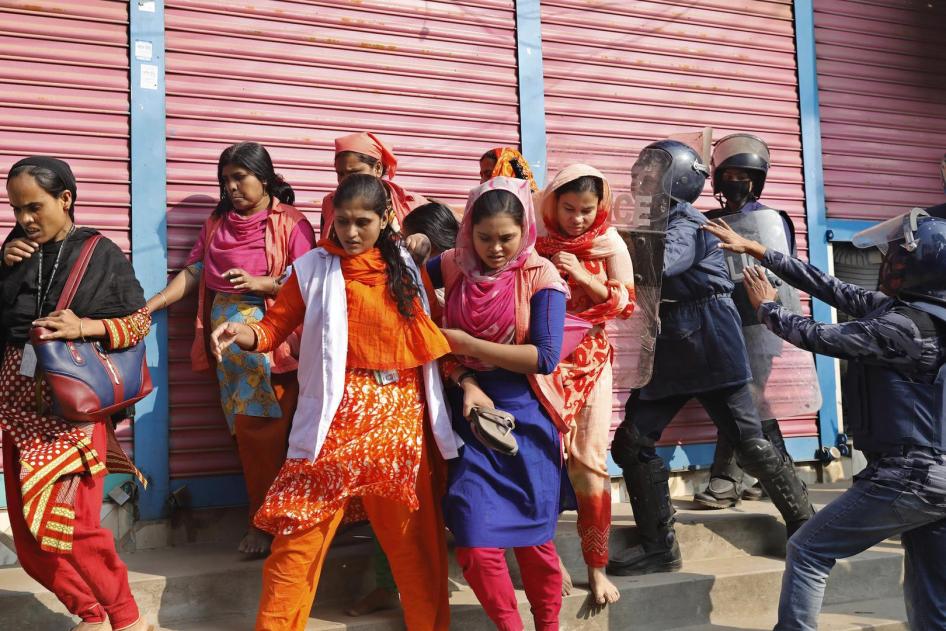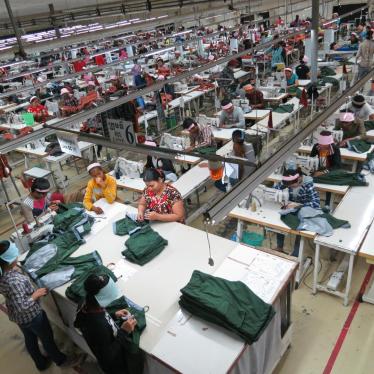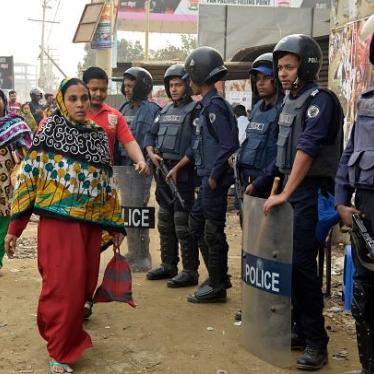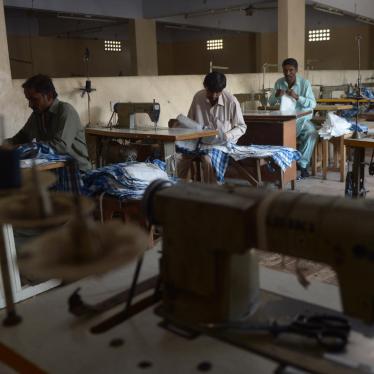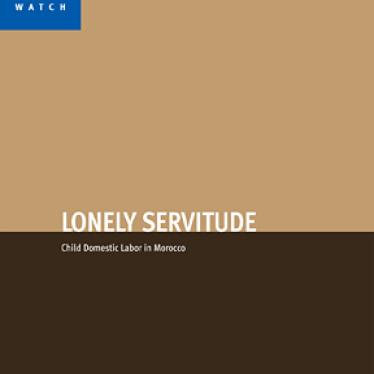(New York) – Bangladesh authorities should immediately investigate garment worker and union leader allegations of arbitrary dismissals and false criminal cases following a recent protest demanding a wage hike, Human Rights Watch said today. Global garment brands sourcing from Bangladesh should investigate these allegations and call for an end to all forms of intimidation of workers.
After strikes in mid-January 2019, union leaders have reported at least 7,500 garment workers were dismissed from their jobs. Some of those dismissed were accused of vandalism and looting, but the allegations appeared broad and vague. At least 29 criminal cases have been filed naming 551 individuals, as well as over 3,000 unidentified people, leaving workers at risk of being arbitrarily accused in one of these cases at a later date. Over 50 workers have been arrested, 11 of whom were denied bail.
“Bangladesh has made international pledges to ensure worker safety and protect their rights, but is falling short of its commitments when workers strike to demand a livable wage,” said Phil Robertson, deputy Asia director at Human Rights Watch. “Factories in Bangladesh should not use false criminal complaints and mass terminations to stifle workers’ collective action.”
Over 50,000 garment workers in Dhaka, Ashulia, Narayanganj, Savar, and Gazipur districts participated in wildcat strikes in mid-December and again in mid-January, protesting wage changes that went into effect December 1, 2018. In December, union leaders said that government officials had threatened them in public and private settings that they would be arrested or disappeared if the protests continued ahead of the December 30 general elections. When protests were organized again in January, Bangladesh police used water cannons, tear gas, and rubber bullets against them, witnesses told Human Rights Watch. One worker was killed and over 50 injured.
Human Rights Watch interviewed eight witnesses to the police violence, fourteen dismissed workers, and three union leaders, and also reviewed lists of fired workers and dismissal notices posted on the factories.
On January 8, Sumon Mia, 22, was shot and killed during the protests by the police, said a witness whose name, like those of other people interviewed, has been withheld for his protection. A colleague of Mia’s told Human Rights Watch that he and Mia were returning from their lunch break when they got caught in the protests: “Police started shooting and the workers started running away, so Sumon and I started running and suddenly Sumon was shot in his chest and he fell down. I fled.… Later I found Sumon’s body lying in the road. The police didn’t even take his body.”
Also on January 8, police raided the Savar neighborhood outside Dhaka where many workers live, seeking people who had participated in the protests. A bystander said she was shot as she stood at her darkened window on the second floor of her building. She told Human Rights Watch: “The police were raiding house to house and when they were heading toward our house, I heard them firing. I heard six rounds of firing. Two hit my glass window and one went through, hitting my lower abdomen.… They were just shooting randomly.”
H&M released a statement on February 7 calling for “respectful negotiation and peaceful dispute resolution,” and regular revision of the minimum wage level in Bangladesh. H&M also signed a Memorandum of Understanding with factory management, associated trade unions, and worker representatives to ensure that “documents and agreements that have now been signed are acknowledged and approved by all parties, outlining valid information, and appropriate grounds for termination of employment” for the workers who were dismissed from the three factories that produce for H&M.
The use of criminal complaints against large numbers of “unknown” people is a common abusive practice in Bangladesh, allowing the police to intimidate and threaten virtually anyone with arrest, repeatedly re-arrest detainees even though they are not the named accused in the cases, and thwart bail. Union leaders told Human Rights Watch that many workers were in hiding out of fear of arbitrary arrest under these unnamed cases. Human Rights Watch has documented previous use of this technique. That union leaders and workers are in hiding demonstrates the chilling effect such a practice has on freedom of association and other basic rights.
Brands sourcing from Bangladesh like H&M, KiK, Tchibo, Lidl, Mango, Next, Matalan, VF, Takko, ALDI, Marks & Spencer, Esprit, Walmart, JCPenny, and Tesco have the responsibility to respect and protect workers’ rights. They should call for an end to dismissals based on the exercise of basic rights and other forms of intimidation.
“It’s grotesque to imagine police raiding homes and indiscriminately shooting rubber bullets into the workers’ neighborhood, but that is exactly what Bangladesh authorities have resorted to,” Robertson said. “The Bangladesh government should instead demonstrate to the international community – and the customers of its US$36 billion garment industry – that it is serious about committing to workers’ rights and safety.”
Strikes and Aftermath
The Bangladesh garment industry employs about four million workers and is the second-largest garment exporter worldwide, after China, generating exports of about US$36 billion. Roughly 83 percent of Bangladesh’s export earnings come from clothing sales abroad, and the industry wields considerable power. But the country’s dismal labor rights record is marked by persistent abuses including government intimidation of unions and poor fire and building safety.
December and January Strikes
Over 50,000 garment workers went on strike from December 6 to 12, 2018, and January 6 to 13, 2019, following a December 1, 2018 increase in the minimum wage from 5,300 taka (US$63) to 8,000 taka (US$96) per month. Workers and union leaders who had campaigned for a minimum monthly wage of US$193 contended that the wage increase essentially only applied to entry-level workers, and that there were only marginal increases for other workers. Police used excessive force following the strikes.
In response to the protests, the government formed a tripartite committee to review garment worker wages, and on January 13 announced modest increases for lower and mid-range worker grades, although the minimum wage of 8,000 taka (US$96) per month remained unchanged.
But when workers tried to return to work, they were met with mass dismissals and arrests.
Excessive Use of Force
On January 8, as many as 10,000 workers blocked the roads in the Baghbari area of Hemayetpur in Savar, north of Dhaka. At approximately 8:30 a.m., police fired rubber bullets, tear gas, and water cannons to disperse the crowds. Once the crowds were dispersed, at approximately 9:30 a.m., police raided homes in the nearby neighborhood where many garment workers live, shooting at residents with rubber bullets.
Human Rights Watch interviewed eight people who were present during those raids, including four who were shot and injured by rubber bullets. Their names have been withheld for their protection.
One of the landlords in the neighborhood told Human Rights Watch:
I have rented 12 rooms here to garment workers. On that day [January 8], all of them went to their factories and then came back before 8.30 a.m., saying that the factory work was suspended since many workers were striking. Then suddenly I saw from the rooftop of my house that police were raiding every house, and I could hear shooting. Then they entered my house, kicked down the doors of every room, and broke the windows searching for the garment workers. Later, I found two of my tenants were shot in the leg.
One of the tenants who was shot said that when the police banged on his door, he “opened the door because my 8-year-old son was crying out of fear from the banging on the door and my wife was asking me to open the door because [I am a Line Chief supervisor], not a worker, so the police would understand that I would not attend the protest.” When he opened the door and showed the police his ID card, he said, they seemed convinced.
But then another police officer kicked him, alleging that he had hurled bricks at the police during the protest. When he fell to the ground, the officer kicked him again and shot him in the leg with rubber bullets at close range. The worker said that it cost 90,000 taka (US$1,072) to remove the bullet from his left leg, nearly a year’s wages under the new wage increase.
The other tenant who was shot spoke to Human Rights Watch while he was being treated at Enam Medical College & Hospital. He said that he was shot in his right thigh by the police through his window when he refused to open the door. He later left the hospital and fled to his home village, fearing police would come for him again.
A woman who is not a garment worker was shot while she was standing at her window on the second floor of the building where she lives:
The police were raiding house to house, and when they were heading toward our house, I heard them firing. I heard six rounds of firing. Two hit my glass window and one went through, hitting my lower abdomen.… I was standing behind my window. The glass of my window is not transparent, so there is no way they could have identified me standing there on the second floor. They were just shooting randomly, and thus I was hit with their bullets. This is really inhuman.
Her husband wants to file a case against the police, she said, but she does not want to for fear of retaliation from the police.
Retaliatory Firing, Blacklisting of Factory Workers
At least 7,500 workers so far have been fired following the January 2019 strikes, according to information from labor groups that Human Rights Watch reviewed. Agence France-Presse quoted an unnamed senior police officer saying that factories had “dismissed 4,899 workers due to the unrest.”
Workers arrived at their factories to find notices posted on the gates with their photograph, name, unit, personal details, and the notification that they were suspended for their involvement in vandalism of the factory. Human Rights Watch photographed some of these notices, none of which provided an account, let alone evidence, of what the worker allegedly did that implicated them in vandalism, but instead included only broad, vague allegations addressed to a group of workers. These retaliatory dismissals and suspensions appear arbitrary.
Union leaders estimate that over 1,700 of the suspended workers are currently blacklisted from working at other factories. The unions said they based their estimates on accounts of workers who, learning that they had been fired, sought employment at other factories but were turned away because their status had been shared among manufacturers.
One worker who said he had been blacklisted told Human Rights Watch: “[The wage reform had] increased my salary by no more than 300 taka [less than US$3.50 per month], but the termination affects my whole family. Most of the people you are talking to here are the breadwinners of the family.” He added: “It’s not like we will get another job in another factory. The factories know that the workers who are terminated were terminated because they took part in the protest.”
Under international human rights law, any penalties for participating in an illegal strike should be proportionate to the offense or fault committed. Human Rights Watch considers dismissal for exercising the right to strike a disproportionate disciplinary sanction. The International Labour Organization (ILO) considers sanctions for participating in strikes acceptable only when national law itself is consistent with international standards on freedom of association.
The ILO committee charged with interpreting the application of the international labor standards, the Committee of Experts on the Application of Conventions and Recommendations, has stated that “sanctions for strike action, including dismissals, should be possible only where strike prohibitions are in conformity with the principles of freedom of association.” The committee has repeatedly held the Bangladesh Labour Act to be in violation of ILO conventions on freedom of association and collective bargaining.
While the right to strike is not absolute in international law, and thus may be subject to certain restrictions, the ILO Committee on Freedom of Association has “made it clear that [the right to strike] is a right which workers and their organizations (trade unions, federations and confederations) are entitled to enjoy,” and that any restrictions on this right “should not be excessive,” and that the “legitimate exercise of the right to strike should not entail prejudicial penalties of any sort, which would imply acts of anti-union discrimination.”
Arrests
Human Rights Watch is aware of 29 criminal cases naming 551 workers and at least 3,000 unnamed accused in relation to the strikes. Union leaders told Human Rights Watch that as of March 4, 52 workers had been arrested, 11 of whom had been denied bail and remained in detention. At least two workers were being held on attempted murder charges under Penal Code section 307, which carries a life sentence.
A woman who has been working in the garment sector for the last four years was named in one of the criminal cases. She told Human Rights Watch: “I was so surprised to see my name in the case. Many officials in the factory know me very well, and they know I wouldn’t join any protest or vandalize the factory property. But still I am named as accused.”
Union leaders also told Human Rights Watch that workers reported being approached by representatives of “yellow unions” – that is, unions set up or controlled by the employer to prevent the establishment of a genuine trade union – and being pressured to sign a template document stating that they accept responsibility for the protests and damage to the factories. They were told that if they signed this letter and submitted it to the Bangladesh Garment Manufacturers and Exporters Association (BGMEA), they would receive one month’s notice and get their back wages, essentially trying to get workers to admit guilt to get pay owed to them, even if they had not engaged in any vandalism.
